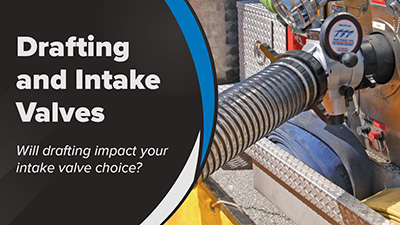How Does Drafting Impact Your Intake Valve Choice?
Is your intake valve optimized for your drafting operations?
To get the most out of your drafting ops, your intake valve needs to have the largest waterway available resulting in the highest flow rate possible with the least amount of friction loss. You are already pulling the water up from the source through the hard suction hose and into the pump. With this in mind, you don’t want the intake valve to restrict that any further.
In this article, we will discuss why your intake valve choice matters, and three factors that might affect the choice you make.
Why Does Your Intake Valve Matter?
Unlike a pressurized water supply coming from a hydrant, drafting requires you to pull water from a static source by priming. Pulling water through 20 or more feet of hard suction hose against the effects of elevation results in added friction loss. This means when the water finally gets to the intake valve at the pump, you don’t want an intake valve that adds extra friction loss. Your intake valve can be optimized to minimize friction loss, ensuring you get the most amount of water on the fire, in the fastest way possible.
The water quality and the environment can also impact your intake valve decision. If the water in your response district is brackish or you are an oceanside fire department that uses saltwater, an extended corrosion warranty should be considered to maximize the life of your valve. Departments in cold climates can experience freezing or cracking valves if the valve is constructed in a way that allows standing water to be always on the inside of the valve, even when it’s not in use. A way to overcome this is to be attentive to the style of the valve and be sure that it keeps the inside of the intake valve dry when it’s not in use, so there is no risk of freezing.
Overall dimensions of an intake valve are more important than ever before because pump panels can be behind a roll up door, low to the ground, or surrounded by close fitting 2.5” truck discharges. A low-profile design should be considered so that the intake valve can be installed on the truck properly.
What Factors May Impact Your Decision?
If you draft often, you should consider these three things when optimizing your intake valve selection for drafting:
What is your Static Water Source?
Your water source won’t run dry if you have an abundant static source like a lake, pond, or river. With a large waterway on your appliance, you will be able to supply the most water to your pump with the least amount of added friction loss.
On the other side of that coin, if you use a portable tank for drafting, you may not want the largest waterway. Since these water sources are limited, some departments prefer to pace water usage instead of taking it to the max to avoid an interruption in your operation and/or cavitation.
How Many Intake Valves Do You Need?
There are a couple of great reasons to consider multiple intake valves for your apparatus.
If you are a department that does a lot of high-volume drafting, you may want two intake valves to set up a twin tube draft. In this setup you can pull additional water into your pump and supply high volumes for the fire ground because you are maximizing the water into the pump.
A second intake valve can also be helpful if you have a lot of variety in where your water source is. How you pull up and where the water source is located becomes easier to navigate when you have more than one intake option. If you are only using one intake valve, you can set up on whichever intake is best positioned for water source access. If you decide you need to draft more water, you can always set up a twin tube draft using the second intake!
How Big of a Waterway Do You Need?
It’s easy to overlook friction loss and waterway size when you are choosing an intake valve that fits on your pump panel. However, you should consider how big of a waterway you really need before making a final decision.
For departments that move big water and want limited friction loss, you should look for the biggest unobstructed waterway possible.
For drafting, we almost always recommend the largest waterway size, but there may be some exceptions. For departments that rarely draft, have a crowded pump panel on the truck, and/or have no pressure supply issues on their hydrants, a smaller waterway built into a smaller sized intake valve is perfectly acceptable.
Moving Forward
As you move closer to an intake valve decision, keep your drafting operations in mind. It’s important to compare your options and consider exactly what your department needs to be successful.
What TFT Ball Intake Valve Do We Recommend for Drafting? Find out Here!
